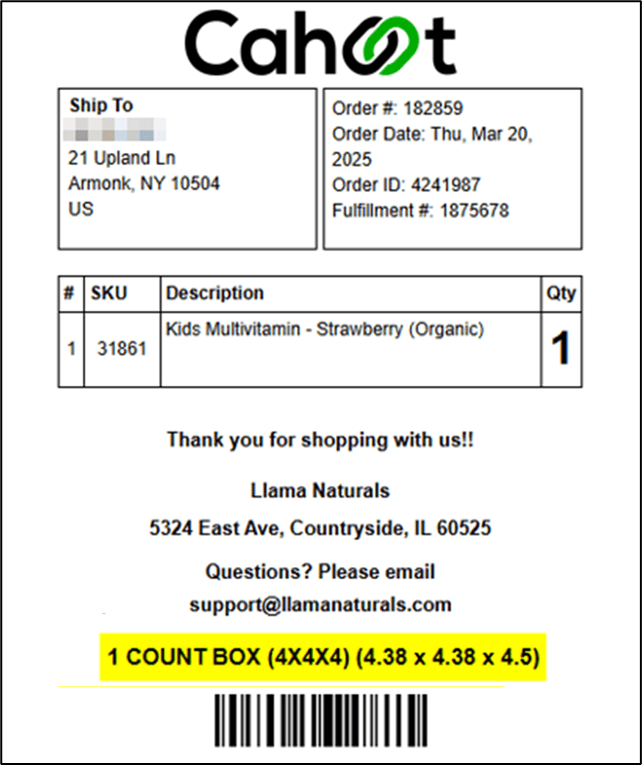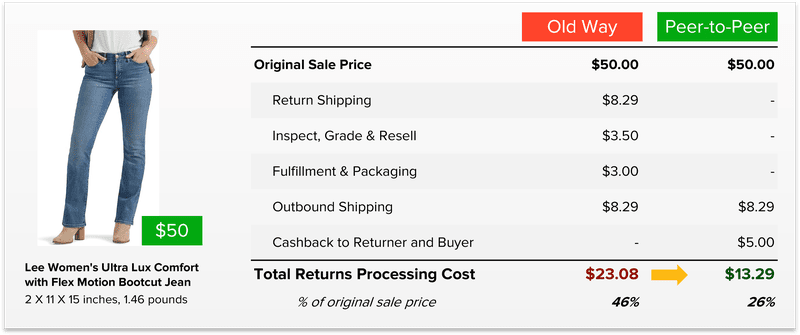Packing Slip: Essentials & Best Practices for Accurate Shipping

Last updated on April 01, 2025

In this article
 10 minutes
10 minutes
- Key Takeaways
- What is a Packing Slip?
- Key Elements of a Packing Slip
- Packing Slip vs. Other Shipping Documents
- Importance of Packing Slips in Ecommerce
- Printing and Customizing Packing Slips
- Digital Packing Slips: Advantages and Implementation
- Best Practices for Using Packing Slips
- Case Studies: Successful Use of Packing Slips
- Summary
- Frequently Asked Questions
A packing slip is essential for ensuring accurate deliveries of ecommerce orders. It provides a list of the items in a package, helping recipients confirm they’ve received everything. In this article, we’ll explain what a packing slip is, why it’s important, and how to create one that is effective.
Key Takeaways
- A packing slip is a critical document that itemizes shipment contents, aiding in order verification, inventory management, and customs clearance.
- Key elements of an effective packing slip include accurate sender and receiver details, item descriptions, quantities, and SKU numbers, ensuring clarity and order accuracy.
- Utilizing packing slips effectively enhances customer satisfaction and operational efficiency, as demonstrated by companies like Walmart and FedEx through improved inventory management and expedited customs processes.
What is a Packing Slip?
A packing slip is a document that is included inside a package that is shipped to a customer to fulfill their online order. It contains an itemized list of the products inside. Also known as a packing list, this document accompanies shipments of goods, providing detailed information about the contents of the package. The primary purpose of a packing slip is to inform the recipient about what is included in the shipment, what is intentionally missing, and why, as well as to help them verify that they have received all items as expected.
Packing slips help identify damaged items during transit, ensure order accuracy, and facilitate potential refunds. Additionally, they assist in tracking inventory levels, ensuring all ordered items are included in a shipment, confirming that it is complete and accurate. Typically, a packing slip includes details such as the order number, date of shipment, sender and recipient information, as well as an itemized list of the shipment contents.
In the context of international shipments, packing slips are used by customs to estimate the shipment’s value, further highlighting their importance. Listing all items in a shipment, packing slips ensure accurate delivery and contribute to a seamless shipping workflow.
Key Elements of a Packing Slip

Several key elements must be included in packing slips to serve their purpose effectively. Sender’s name, address, and contact information are vital for proper identification. Accurate receiver information, including the recipient’s name, address, and any special instructions, helps avoid delivery issues.
The itemized list in a packing slip should detail each product with its name, description, quantity, and unit price for verification. Additionally, important elements like SKU numbers and customer information should be present on packing slips to avoid confusion, ensure smooth processing, and facilitate speedy customer service if needed after delivery.
Including these details helps maintain order accuracy and facilitates efficient inventory management.
Packing Slip vs. Other Shipping Documents
Packing slips serve a unique role in the shipping process, providing an itemized list of the contents within a shipment to ensure clarity and accuracy for both warehouse staff and customers. However, they are not the only documents involved in shipping; a shipping label is also essential.
Understanding their specific function involves comparing packing slips with other shipping documents like invoices, bills of lading, and delivery notes.
Difference Between a Packing Slip and an Invoice
Packing slips verify shipment contents, while invoices provide payment information. Invoices serve as formal records of transactions, including payment terms and due dates, whereas packing slips are simply meant for verifying shipment contents. Unlike invoices, packing slips do not usually display the price of the items, focusing instead on the delivery details.
Difference Between a Packing Slip and a Bill of Lading
A bill of lading acts as a legal contract between the involved parties, while a packing slip serves as an internal document summarizing shipment contents. Packing slips list the items included in the shipment without legal obligations. A bill of lading, on the other hand, signifies ownership transfer from the Seller to the buyer and is handled by the shipping company.
Packing slips detail shipment contents without payment methods or contractual obligations, while bills of lading serve as contracts and invoices request payment. This distinction highlights the unique function of packing slips.
Difference Between a Packing Slip and a Delivery Note
Packing slips provide detailed descriptions and quantities of shipped items, while delivery notes confirm the delivered items. Packing slips itemize shipped products with relevant details. Delivery notes confirm receipt without detailing discrepancies or financial information.
In summary, while packing slips provide comprehensive details about the order, delivery notes focus solely on confirming the receipt of items. This distinction further clarifies the specific roles each document plays in the shipping process.
Importance of Packing Slips in Ecommerce
In the ecommerce supply chain, packing slips serve as formal records accompanying order delivery. Recipients can verify that all items have been received compared to what was intended to be shipped, linking online orders to physical products, ensuring accuracy such that customers receive what they paid for. This verification reduces disputes and returns by allowing customers to quickly identify if their order is correct. Accurate order fulfillment and customer satisfaction depend on this verification process.
Some packing slips display Quantity on Hand, which enables warehouse staff to physically confirm how many units of each product are available during the shipping workflow; a mini cycle count of sorts. These documents help track shipped items, making inventory management more accurate. Therefore, packing slips help businesses maintain accurate inventory levels so they create purchase orders to replenish depleting items when necessary.
Accurate packing slips serve as an extension of a brand, providing an opportunity for customer engagement during the unboxing experience. Including warranty details or return instructions can clarify procedures and reduce customer service time. Showing care in fulfillment accuracy satisfies customer expectations and leads to repeat customer orders.
Printing and Customizing Packing Slips
Methods to print packing slips include Excel templates, shipping software, and integrated ecommerce platforms. Customizing packing slips enhances brand identity and improves customer engagement. Customization ideas include adding logos, colors, product images, and promotional messages.
Methods to Print Packing Slips
Adobe Commerce, Shopify, Amazon, and eBay support printing packing slips. They can also be printed directly from online marketplaces like Etsy and WooCommerce. Dedicated shipping software allows batch printing for multiple orders, streamlining the process.
Tools for professional packing slips include DIY packing slip templates in Excel and Google Sheets, labeling services, and inventory management software.
Customizing Packing Slips
Customizing packing slips creates a cohesive brand experience, enhances customer engagement, and improves retention. Enhancements can include logos, colors, product images, and promotional offers or social media prompts. Strategies include offering discounts, exclusive coupons, or promoting new products and upcoming sales.
High-quality paper can positively impact customers’ perceptions of the brand. Eco-friendly materials align with sustainable branding efforts. Incorporating customer names or gift messages on packing slips can enhance the personal touch and improve customer experience.
Custom packing slips can also feature seasonal themes to resonate with customers during holidays.
Digital Packing Slips: Advantages and Implementation
Digital packing slips offer several advantages over traditional versions. They reduce paper waste, provide faster access to details, and streamline delivery. Amazon’s transition to digital packing slips, for example, reduced paper usage by 30% within a year and streamlined the packing process by removing steps. Using digital versions or recycled materials promotes sustainability, appealing to environmentally-conscious customers.
They can also include QR codes linking to product reviews or additional information, such as product demos. This feature facilitates easy access to online resources, enhancing customer experience and engagement.
Implementing digital packing slips not only benefits the environment but also boosts operational efficiency and customer satisfaction.
Best Practices for Using Packing Slips
Standard practices for packing slips can significantly enhance shipping efficiency and accuracy. Effective packing slips serve as checklists detailing shipment contents, improving accuracy and efficiency. Using a customizable packing slip template can streamline their creation, printing, and automating generation and printing minimizes errors and adds efficiency gains.
Double-Checking Information
Verifying the accuracy of information on packing slips helps prevent shipping errors. Double-checking item quantities and descriptions avoids mistakes and confusion during shipping. Accurate packing slip information before dispatch reduces discrepancies and ensures the correct items are shipped.
Including All Necessary Details
A packing slip should include Buyer and Seller information, item descriptions, quantities, weights, SKU or UPC codes, and the shipping address.
Keeping Consistent Formats
A uniform format streamlines fulfillment and reduces mistakes. A consistent layout and design imply professionalism and clarity. Standardized formats streamline operations and reduce errors by providing repeatable consistency, making the process more efficient.
Case Studies: Successful Use of Packing Slips
Case studies from companies like Walmart and FedEx demonstrate the benefits of using packing slips effectively. Integrating packing slips with inventory management systems has led to remarkable improvements in operational efficiency and customer satisfaction.
Walmart’s Inventory Management Integration
Walmart achieved a 15% decrease in inventory errors and improved operational agility by integrating packing slips with its inventory management system.
FedEx’s Customs Clearance Efficiency
FedEx automated the creation of packing slips, which helped reduce the time required for customs clearance and reduced customs clearance delays by 20%, enhancing overall shipping efficiency and delivery times.
Summary
Packing slips are indispensable tools in the shipping process, providing detailed information about the contents of a package and ensuring order accuracy. They play a vital role in inventory management, customer satisfaction, and operational efficiency. By understanding the differences between packing slips and other shipping documents, businesses can utilize them more effectively to streamline their shipping processes and enhance customer trust.
Implementing best practices for creating and using packing slips, such as double-checking information, including all necessary details, and maintaining consistent formats, can significantly improve shipping accuracy and efficiency. The case studies of Walmart and FedEx illustrate the tangible benefits of integrating packing slips with inventory systems and automating their generation for customs clearance. Embracing these practices can lead to smoother operations, fewer errors, and happier customers.
Frequently Asked Questions
What is the difference between a packing slip and a delivery slip?
The key difference between a packing slip and a delivery slip lies in their purpose: a packing slip details the contents of the shipment, while a delivery slip, or delivery note, serves as proof of delivery and typically requires a signature. Thus, a packing slip focuses on item details, whereas a delivery slip confirms successful delivery.
What is a packing slip?
A packing slip is a document that itemizes all the products included in a package, serving as a reference for both the sender and the recipient. It contains essential details like SKU numbers and quantities to ensure accurate order fulfillment.
What information is typically included on a packing slip?
Packing slips typically include buyer and order information, a list of items with quantities, product weight, and SKU or UPC codes. This ensures clarity and organization during the shipping process, which in turn minimizes fulfillment mistakes.
What role do packing slips play in increasing customer satisfaction?
Packing slips show that a business values accuracy in fulfilling orders, engendering trust with customers and encouraging repeat purchases.

Up to 64% Lower Returns Processing Cost


